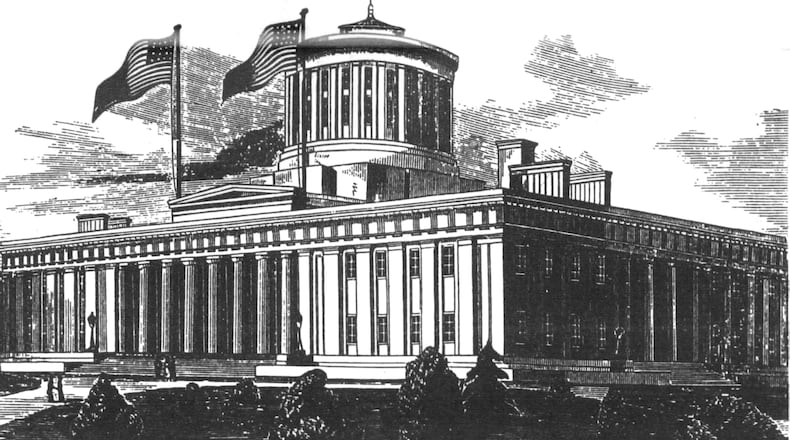There were five principal architects of the building, with contributions from several others.
One of the most notable Statehouse architects was Warren County-born Nathan B. Kelley, who lived and worked most of his life in Columbus.
A slow start
Construction actively began on July 4, 1839, with the ceremonial laying of the cornerstone.
There were prolonged weather-related breaks in many of the early years of construction.
The building took a total of 22 years to complete, with prison laborers doing much of the work.
Nathan Kelley takes over
Nathan Kelley was hired to take over the job in 1854.
The Statehouse project was already 15 years underway when Kelley was hired. The previous architects had taken the blueprints and plans with them, leaving Kelley a massive puzzle to solve.
Credit: Barbara J. Perenic
Credit: Barbara J. Perenic
Much of the exterior work on the building was complete, except for the roof. Kelley’s contributions focused on the finishing touches of the exterior as well as the interior spaces and major mechanical systems.
It was Kelley who discovered that the Statehouse had been planned without any heating or ventilation system. He solved this problem by building brick walls inside the structure that he referred to as “air sewers” that would function like ductwork in a modern heating system, moving air throughout the building.
He designed a steam heating system that used a centrally located coal fired boiler.
Kelley’s design also called for indoor plumbing, including restrooms, which were considered a major amenity at the time.
Kelley loved ornate design and employed it in the statehouse chamber and rotunda, using an intricate pattern of nearly 5,000 imported floor tiles.
Credit: Bill Ingalls/NASA
Credit: Bill Ingalls/NASA
The Statehouse project was administrated by a group of commissioners.
His ornate style, in the end, led to Kelley’s firing in 1858, after four years leading the project. The commissioners deemed his design style too ornate and expensive for the type of building they wanted.
His plans for several murals and statue of George Washington were also canceled.
According to a 1996 Dayton Daily News article about a then-recently completed statehouse renovation, one of Kelley’s massive limestone chimneys, part of a then-innovative heating system, was left exposed in the cellar “because it looks so neat.”
Kelley’s other notable works and successes
Kelley was born on Feb. 26, 1808, in Warren County.
Very little is known about his life, but it is assumed that he served in the military at some point because some historical documents refer to him as Major Kelley.
There are no known pictures or drawings of Kelley.
Before becoming an architect, Kelley worked as a carpenter, engineer and surveyor.
Kelley was commissioned at age 27 to design the State School for the Blind and the Columbus State Hospital. Both have since been demolished.
Also demolished is the 1840 Franklin County Courthouse, which he designed.
Kelley served as the city engineer of Columbus from 1841-1843.
He was the architect for several other Columbus buildings, such as the Columbus Club and the Hayden Building downtown, both of which are on the National Register of Historic Places.
He also designed Columbus’ first Central High School in 1860.
After the Ohio Statehouse project, Kelley moved to Cincinnati and was the architect for several buildings there and in Kentucky, including two women’s colleges and a building now known as Western State Hospital, a psychiatric institution that still houses patients today.
He then returned to Columbus, where he designed schools, churches, commercial buildings, private residences, the city waterworks, and more.
About the Author



